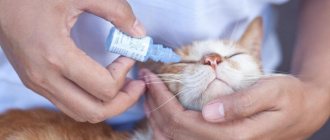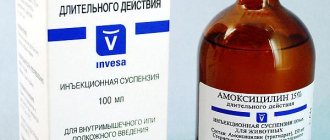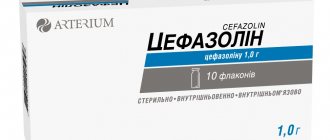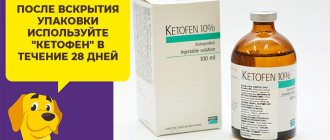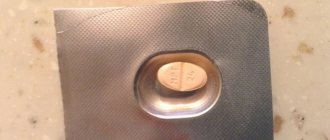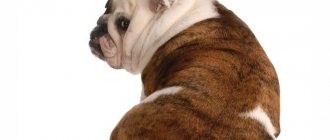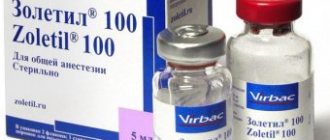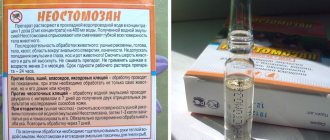Ceftriaxone for dogs is an antibiotic used to treat most diseases of bacterial origin. It is administered only intramuscularly, it is painful, therefore it is diluted with Lidocaine or Novocaine. Not prescribed for puppies (only in extreme cases), pregnant or lactating bitches. The course of therapy lasts 5-10 days, injections are performed 1-2 times a day. The dosage should not exceed 40 mg of the drug per day for an adult dog.
Available in the form of a white powder, when diluted it acquires a slightly yellowish tint. The price of one bottle with 1 g of active substance is 30 rubles.
pharmachologic effect
Third generation cephalosporin antibiotic.
It has a bactericidal effect by inhibiting the synthesis of bacterial cell walls. Ceftriaxone acetylates membrane-bound transpeptidases, thereby disrupting the cross-linking of peptidoglycans necessary for cell wall strength and rigidity. It has a wide spectrum of antimicrobial action, which includes various aerobic and anaerobic gram-positive and gram-negative microorganisms. The drug is active against gram-positive aerobes: Streptococcus group A, B, C, G, Str. pneumoniae, Staphylococcus aureus, St. epidermidis; gram-negative aerobes: Enterobacter spp., Eschenchia coli, Haemophilus influenzae, H. parainfluenzae, Klebsiella spp. (including K. pneumoniae), Moraxella catarrhalis, Morganella morganii, Neisseria gonorrhoeae, N. meningitidis, Proteus mirabilis, Proteus vulgaris, Providencia spp., Salmonella spp. (including S. typni), Serratia spp. (including S. marcescens), Shigella spp., Yersinia spp. (including Y. enterocolitica), Treponema pallidum, Citrobacter spp., Aeromonas spp., Acinetobacter spp.; anaerobes: Actinomyces, Bacteroides spp. (including some strains of B. fraqilis), Clostridium spp. (but most strains of C. difficile are resistant), Peptococcus spp., Peptostreptococcus spp., Fusobacterium spp. (including F. mortiferum and F. varium). After intramuscular administration, it is quickly and completely absorbed. Bioavailability is 100%. The maximum concentration in blood plasma is observed after 1.5 hours. Reversibly binds to plasma albumin (85% - 95%). The drug remains in the body for a long time. Minimum antimicrobial concentrations are determined in the blood for 24 hours or more. Easily penetrates into organs, body fluids (peritoneal, pleural, synovial, in case of inflammation of the meninges - into the spinal cord), into bone tissue. In breast milk, 3 - 4% of the concentration in the blood serum is determined (more with intramuscular than with intravenous administration). The half-life is 5.8 - 8.7 hours and is significantly longer in people over 75 years of age (16 hours), children (6.5 days), and newborns (up to 8 days). The active form is excreted (up to 50%) by the kidneys within 48 hours. Partially excreted in bile. With renal failure, excretion slows down and accumulation is possible.
Indications and mechanism of action
The mechanism of action is the ability of the drug to effectively suppress the synthesis of bacterial cell walls. Antibiotic injections are prescribed during treatment:
- urinary tract infections (pyelonephritis, cystitis);
- lower respiratory tract organs (lung abscess, pneumonia);
- infections of burns, soft tissue wounds, skin;
- bacterial damage to bones and joints;
- otitis media;
- sepsis;
- meningitis.
Can be used to prevent diseases in the postoperative period.
Ceftriaxone for cats instructions for use
You can use this antibiotic to treat your pet only as prescribed by a doctor, and strictly following the dosage. The drug is available in powder. Therefore, first you need to dilute it with Novocaine. Cats should not use Lidocaine for dissolution. For 1 g of antibiotic, you need to take 2 ml of painkiller and 2 ml. The medicine is administered to the cat intramuscularly or intravenously through a catheter. In the latter case, this must be done by a doctor.
How much Ceftriaxone should be injected into a cat? The dosage is calculated depending on the weight of the animal:
- for small cats weighing less than 2 kilograms, no more than 0.5 ml of the drug solution can be administered at a time;
- larger pets need to be administered 1 ml of Ceftriaxone.
Injections should be given once a day, but sometimes the doctor recommends dividing the daily dose into two times. Treatment lasts from 7 to 10 days, depending on the severity of the animal’s condition. If the cat feels better before the end of this period, the injections are not stopped. You need to complete the full course prescribed by your doctor.
Animal owners need to know that after treatment with Ceftriaxone, the cat cannot be mated for 3 months, otherwise there may be complications during pregnancy, and the kittens may die.
Ceftriaxone is an antibiotic familiar to many from painful injections and is also used in veterinary medicine. They treat diseases caused by microorganisms. If ceftriaxone is prescribed to treat a cat, it means that there is an infectious disease of the gastrointestinal tract, respiratory or genitourinary systems, otitis media, inflammation of bone or soft tissues.
Pharmacology and purpose
The antibiotic disrupts the functioning of enzymes that ensure the strength of bacterial cell membranes. Destroys mainly Cocci, as well as Escherichia coli. This is necessary to prevent postoperative complications.
Bacteria adapt to the action of antimicrobial drugs; old panaceas are being replaced by new ones, such as Ceftriaxone. The antibiotic has found application in the treatment of the following diseases of dogs, cats, cows, pigs, goats, rabbits, and poultry:
- infections of the alimentary tract and bile ducts;
- urogenital diseases;
- cerebral pathologies;
- infected wounds;
- skin diseases;
- respiratory infections;
- sepsis;
- bone diseases;
- prevention of postoperative complications.
Ceftriaxone for cats instructions for use
You can use this antibiotic to treat your pet only as prescribed by a doctor, and strictly following the dosage. The drug is available in powder. Therefore, first you need to dilute it with Novocaine. Cats should not use Lidocaine for dissolution. For 1 g of antibiotic, you need to take 2 ml of painkiller and 2 ml. The medicine is administered to the cat intramuscularly or intravenously through a catheter. In the latter case, this must be done by a doctor.
How much Ceftriaxone should be injected into a cat? The dosage is calculated depending on the weight of the animal:
- for small cats weighing less than 2 kilograms, no more than 0.5 ml of the drug solution can be administered at a time;
- larger pets need to be administered 1 ml of Ceftriaxone.
Injections should be given once a day, but sometimes the doctor recommends dividing the daily dose into two times. Treatment lasts from 7 to 10 days, depending on the severity of the animal’s condition. If the cat feels better before the end of this period, the injections are not stopped. You need to complete the full course prescribed by your doctor.
Animal owners need to know that after treatment with Ceftriaxone, the cat cannot be mated for 3 months, otherwise there may be complications during pregnancy, and the kittens may die.
Source medicont.ru
Short description:
this drug has a wide spectrum of antibacterial action. It has a detrimental effect on staphylococci, streptococci, enterobacteria, Klebsiella, Shigella and many other pathogens. Veterinarians prescribe this third-generation antibiotic to animals suffering from infections of the genitourinary system, respiratory system, soft tissues, and skin. Ceftriaxone is used to treat otitis, meningitis, and sepsis. It is used to prevent the occurrence of postoperative complications.
For whom:
for cats and dogs, but can also be used for other mammals.
Leave form:
this antibiotic is a white or yellowish crystalline powder, which is packaged in glass bottles sealed with rubber stoppers. Vials, each containing 2 g, 1 g, 0.5 g or 0.25 g of ceftriaxone sodium salt, are packed in 10 pieces in cardboard boxes.
Dosage:
The powder is intended for intramuscular or intravenous injections. For intramuscular injections, the powder is diluted in novocaine, lidocaine or water for injection, and for intravenous injections - in sterile water for injection (for jet administration), in saline solution or in 5% glucose solution (for drip administration). The dosage of the drug, the method of its use and the frequency of administration are prescribed by the veterinarian individually. For cats, lidocaine is not used to dissolve the powder. The daily dosage of this antibiotic is approximately 20-40 mg per kg of animal weight. The drug is administered, as a rule, for 5-10 days.
Restrictions:
The use of Ceftriaxone is contraindicated if the animal has liver or kidney failure, as well as if there is hypersensitivity to antibiotics belonging to the cephalosporin group. This medicine should not be administered to pregnant females. In dogs, the use of high doses of this antibiotic for treatment can lead to cholelithiasis.
Source vet.apreka.ru
Ceftriaxone is considered an antibacterial agent and is often used in veterinary medicine. The medicine fights even advanced forms of pathologies, while other drugs cannot cope with them.
This antibiotic is not only effective, but also strong. Therefore, before you start using it, you should definitely consult a veterinarian.
How is ceftriaxone supplied in its release form?
Powder for injection in vials containing 500 mg, 1 g or 2.0 g of ceftriaxone sodium salt.
The duration of administration depends on the condition being treated, the response to treatment, and the development of any side effects. Be sure to complete the course unless specifically directed by your veterinarian. Even if your pet feels better, the entire treatment plan must be completed to prevent relapse or prevent bacterial resistance from developing antibiotic resistance.
^Top
Solvent selection
You need to know how to dilute Ceftriaxone so as not to harm a person. Some drugs with ceftriaxone as an active ingredient are already sold with solvents.
Water
When diluting Ceftriaxone with water only, pain will be felt at the injection site.
Sometimes, only water for injection is used to dilute the powder - for intravenous use, the patient is allergic to other solvents. The proportions will be 1:1.
Lidocaine
Diluting Ceftriaxone with Lidocaine helps avoid painful injections.
This is important when carrying out a course of antibiotic treatment. In dissolved form, the product can be stored for no more than 6 hours, then it will be unsuitable for injection, its chemical composition and physical properties will change
Ceftriaxone with Lidocaine is used only for injection into the muscle. This substance is not used for intravenous administration due to its negative effect on the heart. You need to be careful with Lidocaine due to the high risk of developing allergies.
It is necessary to do a drug tolerance test before the injection. Apply a drop of each medicine separately to the inner bend of the elbow, and make 2 scratches with a scarifier. After 10 minutes, the results are assessed. If the area begins to itch or turn red, then it should not be diluted with lidocaine.
Novocaine
When self-injecting an antibiotic, Novocain is used for dilution. This is an analogue of Lidocaine, which is used to short-term reduce pain during injections. Alcoholic beverages are contraindicated for the patient during course therapy with this drug.
The antibiotic can be diluted with Novocaine when given intramuscularly. Prepare the solution just before use.
If there is any powder left in an open bottle, it will have to be thrown away. Ceftriaxone with Novocaine is diluted in proportion taking into account the concentration prescribed by the doctor.
Is it possible to dilute Ceftriaxone Sodium chloride?
Dilution of the antibiotic Ceftriaxone with saline is used in children under 1 year of age, with allergies to other solvents, or for intravenous injections.
A 0.9% solution is used. It must be injected into the muscle slowly or intravenously through a dropper. This will help reduce soreness.
The better to breed
When preparing a solution of Ceftriaxone, you need to decide whether it is better to dilute with Novocaine or Lidocaine. Both substances have an analgesic effect and are allowed when injected into the muscle.
What do you think are the most important factors when choosing a medical facility? Poll Options are limited because JavaScript is disabled in your browser.
Experts recommend using Lidocaine. This remedy is easier to tolerate and does not cause allergies. Novocaine can reduce the effectiveness of the main drug.
Application
Ceftriaxone causes pain, so the preferred eluents for it are analgesics - Lidocaine 1%, Novocaine 0.5%. For intramuscular or subcutaneous administration, the drug is dissolved in 3.6–4.0 ml of eluent. At this dilution, 1 ml contains 250 mg of the active ingredient. The dosage is 20–40 mg/kg of body weight and is specified by a veterinarian. In most cases, a single injection per day is indicated. For intravenous use, use mixtures of analgesic with saline, at the discretion of the doctor.
When is Ceftriaxone used for cats?
Pets often get sick if they are poorly cared for. They have infections that are also common to humans, but in addition, cats also suffer from special diseases. Animals that walk outside are especially susceptible to them. If your furry pet is sick, it is best to contact a veterinarian. Often, when there is an infection, doctors prescribe Ceftriaxone for cats. The instructions recommend using it in the following cases:
They inhibit acetylcholinesterase enzymes and are not irreversible over time. they have lower dermal toxicity than phosphoruses. Clinical signs similar to organophosphates and same treatment. Clinical signs may begin within minutes or days, observing apprehension, hypersensitivity, hypersalivation, vomiting, muscle contractions in the face and neck, convulsions may occur, and the prevalence of hyperthermia.
Treatment: wash with plenty of warm soapy water, inducing vomiting may cause seizures, gastric lavage with saline and activated charcoal after controlling seizures. Always protect yourself with gloves and aprons. Keep animals hydrated and urine output sedated.
- for sexually transmitted diseases, for example, chlamydia;
- in case of sepsis development;
- after castration or sterilization surgery to prevent the development of infection;
- during the recovery period after surgical treatment of urolithiasis;
- with otitis;
- meningitis;
- cystitis;
- for bacterial infections of the respiratory system;
- for infections of the skin and soft tissues.
There was a case involving the ingestion of dog collars soaked in amitraz. Although today they are discontinued. Action: It appears to act as a local anesthetic at the membrane level. Treatment: If the exposure was topical, it should be decontaminated with a bath, and if it was ingested, induction will be done with vomiting, gastric lavage, activated charcoal. The use of atipamezole, serum therapy, antiemetics, and body heating is indicated.
Its toxicity appears to be low, but permethrins are toxic in cats. Treatment: control of excitability and seizures. Maintain hydration and urine output. Action: It causes digestive irritation, oxidative stress and hemolytic anemia, it can cause kidney damage secondary to hemoglobinuria, retinal damage and cataract formation have been observed in rabbits.
Is it possible?
For enteritis
Enteritis is deadly for dogs. As a rule, the disease is characterized by inflammation of the intestines, which can affect any part of the digestive tract. This disease can take the life of an animal in just a day, so it is extremely important to detect symptoms as quickly as possible and begin treatment immediately. Signs of infection:
- abdominal pain;
- diarrhea and vomiting (during the first day);
- sharp, unpleasant odor in vomit and feces;
It is immediately worth noting that without vaccination with a special serum with immunoglobulins, it will not be possible to cure an animal suffering from a viral form of enteritis.
Antibiotics are prescribed to treat the disease. Having a wide spectrum of action, Ceftriaxone has proven itself in the treatment of enteritis in dogs.
Under the influence of the drug, the activity of enzymes that ensure the strength of bacterial cell membranes is disrupted. The medicine prevents the development of re-infection and reduces the risk of complications of the disease.
For piroplasmosis
Piroplasmosis is a disease caused by parasites. When infected, the following symptoms are observed:
- temperature rises;
- appetite disappears, the animal gets tired quickly;
- the dog drinks a lot of water and becomes thirsty;
- dark color of urine;
- diarrhea;
- vomit;
- shaky, uncertain gait;
- rapid breathing;
Important! During the period of complications of the disease with a bacterial infection, Ceftriaxone is added as an antibiotic intravenously or intramuscularly. At a dose of 20-50 mg per kg of body weight per day.
For interdigital pyoderma
For interdigital pyoderma in dogs, Ceftriaxone is not used. Veterinarians more often prescribe antibiotics such as Baytril, Cephalexin, Enrofloxacin, Tyrosine, Clindamycin, etc.
For mycoplasmosis
Ceftriaxone is not suitable for the treatment of mycoplasmosis in dogs. For this disease the following are used: Erythromycin, Levomycetin, Doxycycline, Tylosin.
Is it used to treat fistulas?
Unfortunately, purulent inflammations - fistulas - are quite common in dogs, caused by the body's protective reaction.
A fistula is an area of purulent inflammation connected to the external environment through the fistula canal. Simply put, this is a small and narrow hole through which purulent masses are discharged out through the canal. The disease is similar to an ordinary abscess, but the inflammatory process is much more dangerous.
One of the main aspects in the treatment of fistulas in dogs is the use of broad-spectrum antibiotics. Ceftriaxone is well suited and often used to treat this disease.
Will it help if the mammary gland is swollen?
In a non-pregnant female, the mammary glands should not have any lumps, swelling, redness or discharge. In a pregnant animal, slight swelling of the glands is considered normal.
If the owner notices that the pet’s mammary glands have changed color, shape, become noticeably hardened, etc., then the animal should be examined as quickly as possible and find out what caused this pathology. Ceftriaxone is used to treat mammary glands in dogs, since the use of an antibiotic is indispensable.
Other indications
The drug is used to treat:
- bronchitis, otitis, sinusitis, laryngitis and other pathologies of the respiratory system;
- cystitis, pyelonephritis and other diseases of the genitourinary system;
- sepsis;
- infectious lesions of joints and bone tissue;
- purulent wounds;
- meningitis;
- salmonellosis and other bacterial diseases associated with digestion;
- blood poisoning, etc.
How to give a cat an injection
Not every owner is ready to give injections to their cat themselves, but if circumstances do not allow going to the veterinary clinic for procedures every day, it is necessary to prepare for them at home.
The drug Ceftriaxone is administered intramuscularly (into the thigh muscle).
It is better if the first injection is given to the cat by a clinic specialist, explaining the nuances along the way:
It is preferable to use insulin syringes - their needles are thinner and shorter than regular ones. It will be easier for the animal to endure the injection, and the home doctor will be more relaxed - with such a needle, the likelihood of getting to a greater depth than required is practically eliminated. The injection is given in the thigh muscle, just above the knee. First, you need to carefully feel the installation site with your fingers to understand the volume of the muscle layer. The needle will need to be inserted to a depth of 1-1.5 cm. The animal must be securely fixed and, if possible, calmed
It is important that the owner at this moment is calm and confident in his abilities. This will help carry out the procedure faster and not cause unnecessary suffering to the sick cat.
The syringe is held at 45 degrees in relation to the injection site in the direction from the foot to the thigh. The needle must be inserted into the muscle with a sharp movement. The medicine is administered by applying slow pressure to the plunger of the syringe. At the time of insertion, the paw may tremble. After removing the syringe, you need to loosen the hold on the cat and calm her down again. Since the injection is very painful, it is not recommended to constantly place it in one thigh. The sides need to be alternated.
Ceftriaxone injections are quite painful.
Contraindications
Hypersensitivity, pregnancy, liver and kidney failure. It is not recommended to mix Ceftriaxone with other drugs.
Dry dark chamber, at temperatures below 25 degrees, 3 years. The diluted solution is suitable for 24 hours if stored in the refrigerator.
Ceftriaxone is an effective but unsafe drug that can be used to treat animals under the supervision of a veterinarian.
We invite you to join our Zen channel and group on VKontakte or Odnoklassniki, where new articles are published, as well as news for gardeners and livestock breeders.
Similar articles:
- Trivit vitamins for animals
- Veterinary drug Nucleopeptide
- How to dilute lactic acid for rabbits and other animals?
How to give a cat an injection correctly
To prevent the development of infection after sterilization and for certain diseases, veterinarians often prescribe Ceftriaxone. The owners of the house have to give injections to the cat, this saves time and money on a daily visit to the clinic. But not everyone knows how to give injections. The basic rules are the same as for injections for people: sterility, adherence to the exact dosage, and others. But there are some special features for cat injections.
Treatment: induce vomiting and administer activated charcoal followed by saline catharsis, in case of hemolytic anemia blood transfusion is indicated, steroids can reduce the intensity of hemolysis, prescribe ascorbic acid in case of metaglobinuria and alkalinize the urine to facilitate excretion.
We can also find it in some cleaners. Action: Through the skin they cause local irritation, and if they enter in large quantities, the kidneys may be damaged. Clinical signs: They produce local dermatitis, vomiting and diarrhea with blood and mucus. Muscle weakness and tremors. There is evidence of renal attachment with oliguria and azotemia, causing metabolic acidosis.
- "Ceftriaxone" is administered to the pet intramuscularly. It is best to do this at the back of the thigh. You need to make sure that the animal’s muscles are not tense; to do this, calm the cat down and massage its paw.
- There is no need to lubricate the animal's skin with alcohol, since cats have an antibacterial layer on it. The main thing is that there is no inflammation or dirt at the injection site. And you should not touch the needle with your hands.
- To administer the drug, it is better to use a thin one. It holds just 1 ml. This is exactly how much Ceftriaxone solution is needed for large animals. This syringe is better because it has a thin needle. This injection is already painful, but with a thick needle it will be even worse.
- It is better to have someone hold the cat during the procedure. The injection must be done with clear, confident movements, and try to finish everything quickly.
Treatment: for dermal exposure, wash with plenty of soapy water. Carry out gastric lavage with activated charcoal and then catarrh. There are no specific antidotes, so you must maintain hydration, correct acidosis, induce diuresis.
If ingested, it causes gastrointestinal irritation, nausea and vomiting, with hepatic involvement in cats. Inhalation is very dangerous and can cause depression and seizures. Treatment: Emesia, gastric and catharsis. Small dogs may suffer from mild poisoning. Accidental use in the mouth may increase the risk of toxicity 50-fold.
Application procedure
Cefotaxime is given to cats by injection. If you take it orally, it is not absorbed. The release form of the drug is powder. Before use, it should be diluted - prepare a solution for injection. Dilution is carried out with Novocaine.
Lidocaine cannot be used as an anesthetic for cats.
When preparing the solution take:
- "Cefotaxime" - 1 gr.
- "Novocaine" - 2 ml.
- Water for injections – 2 ml.
You can give a Cefotaxime injection to a cat by intramuscular injection or inject it intravenously using a catheter. Only a doctor should give an intravenous injection.
The dosage of Cefotaxime for a cat is calculated taking into account the pet’s body weight:
- if the cat weighs less than 2 kg - 0.5 ml of antibiotic solution;
- cats weighing more than 2 kg - 1 ml of Cefotaxime solution.
A cat should be injected with Cefotaxime once a day, but often the doctor advises dividing the required volume into several doses. Treatment lasts from 7 to 10 days, it all depends on the clinical picture of the disease. Even if the signs of the disease have gone away and the pet’s health has improved, the injections must continue to be given in the same dose. The entire course prescribed by the doctor must be completed in full.
When treating a cat with Cefotaxime, strictly follow the dosage prescribed by your doctor.
Ceftriaxone for dogs instructions for use
Antibiotics have been used since the end of the 18th century. During this time, the pathogens they were intended to combat acquired resistance. The science of pharmacology does not stand still and has developed highly effective second-generation antibiotics. Over time, they lost their healing effect.
Today, third-generation antibacterial drugs are used with bacteriostatic (delays the proliferation of bacteria) and bactericidal (kills microbes) effects.
The main problem in the treatment of diseases in dogs is the circulation of microbes resistant to antibiotics. It is more often observed in megacities, where antibacterial drugs are widely used.
Resilience is distinguished between acquired and natural. Acquired resistance is the result of contact of a microbe with an antibiotic, natural resistance - the microbe produces enzymes that inactivate the antibiotic.
Mutant forms appear that transmit resistant properties to the next generation of microbes. This is mainly gram-negative flora (salmonella, shigella, etc.). For this reason, pharmacology is developing generations of antibiotics.
The use of cephalosporin drugs in veterinary medicine remains relevant. Rapid absorption and uniform distribution in the organs and tissues of the animal has high bioavailability.
Composition and release form
Ceftriaxone is a 3rd generation beta-lactam antibiotic. Class cephalosporins. They are used widely in medicine and veterinary medicine, more often in the presence of pathogen strains resistant to cephalosporin drugs, penicillins and aminoglycosides.
They produce a white or yellow powder for intravenous and intramuscular injections. In glass bottles. The bottle contains 1 g of ceftriaxone sodium salt.
The action of the drug is based on inhibition of the activity of the enzyme transpeptidase and disruption of the biological synthesis of peptidoglycan in the microbial cell wall.
The drug is active against gram-negative and gram-positive microflora:
- Staphylococcus aureus.
- Staphylococcus epidermidis.
- Streptococci.
- Enterobacteriaceae.
- Kine stick.
- Haemophilus influenzae.
- Klebsiella.
- Moraxella.
- Morganella.
- Nesseria.
- Proteus.
- Serration.
- Blue-green stick.
- Clostridia.
- Salmonella.
- Shigella.
- Bacteroides.
- Providence.
- Citrobacter.
Indications for use
Treats the following diseases:
- Infections of the biliary tract and digestive tract.
- Diseases of the kidneys and urinary tract of an infectious nature.
- Inflammation of the brain.
- Infections of wounds, skin, soft tissues.
- Inflammatory infections of ENT organs.
- Blood poisoning.
- Respiratory infections.
- Inflammatory processes of the reproductive system.
- Infectious lesions of bone tissue.
- Postoperative prevention of complications.
Dosage
The drug is intended for use in a hospital setting. The working solution is stored at 22°C for no more than 6 hours, from 2°C to 8°C for a day.
The contents of the bottle are diluted with 3.6 ml of 1% lidocaine solution, 0.25-.0.5% novocaine solution, and sterile water for injection. 1 ml of this solution contains 250 mg of ceftriaxone.
20-40 mg of antibiotic is administered per 1 kg, 1 injection per day. The course of treatment is up to 10 days. After the pathogen has been destroyed and body temperature has stabilized, ceftriaxone injections are continued for another 3 days.
For intravenous jet administration, the powder is dissolved in 9.6 ml of 0.9% physiological solution. 1 ml of this solution contains 100 mg of antibiotic.
When administering the drug more than 50 mg per 1 kg of weight, the solution is administered dropwise over 30 minutes. The contents of the bottle are diluted in 250 ml of physiological solution.
Before use, be sure to consult your veterinarian!
Contraindications
Hypersensitivity to beta-lactam antibiotics and cephalosporins. Contraindicated in dogs suffering from renal and liver failure. Prohibited during the entire period of pregnancy.
Ceftriaxone solution cannot be administered simultaneously with other antibacterial drugs, and it is also prohibited to mix with solutions containing calcium.
Adverse reactions
- Hematopoietic system: anemia, increased number of platelets in the blood, hemolytic jaundice.
- Urinary system: impaired renal function.
- Digestive system: coprostasis, diarrhea, dysbiosis, enterocolitis, liver dysfunction.
- Allergic reaction: skin rash, chills, itching, anaphylactic shock.
- Pain at the injection site; with intravenous administration - inflammation of the vein wall.
Possible complications
If the doctor’s prescriptions are not followed, or an allergic reaction begins to develop in the dog’s body, the following complications may occur:
- dysbacteriosis, accompanied by vomiting and diarrhea;
- disturbances in the functioning of the kidneys, manifested by uncontrolled urination or a change in the color of urine to dark brown;
- problems in liver functionality, up to liver failure.
When examining the dog, the doctor will detect severe anemia and an increase in the number of platelets in the blood.
Price and analogues
Dispensed in pharmacies with a specialist prescription. The price for a 1 g bottle ranges from 25 to 30 rubles.
Let's look at analogues among injections:
- Claforan (France), the cost of a bottle is about 120 rubles.
- Cefotaxime (Russia), sold for 25 – 40 rubles. for 1 year
- Rocephin (Switzerland), supplied with solution for injection. The cost of the set is 530-540 rubles.
The potent antibiotic cefotaxime
Ceftriaxone is vital in a number of cases. Despite a number of contraindications and side effects, it is widely used in veterinary medicine.
Source» kotsobaka.com
>
If it gets worse
It is possible that a painful lump will remain at the injection site. In case of allergic reactions, due to intolerance to the substance, a rash, redness, chills, itching, etc. may occur. The development of anaphylactic shock is also possible.
Therefore, if the medication is used for the first time, you should monitor the body’s reaction and have anti-allergy medications with you.
Fell asleep after the injection
If the dog falls asleep after using the drug, it’s not scary. Considering the condition of the animal, this phenomenon is considered normal, but it is better to observe the pet’s behavior. And if the need arises, consult a doctor.
Contraindications and individual intolerance to Ceftriaxone
In most cases, Ceftriaxone is tolerated without negative consequences. In some cases, rare reactions occur. Allergic reactions can almost always be avoided because a sensitivity test is performed before starting antibiotic treatment.
Before starting treatment, you should read the contraindications to the use of Ceftriaxone:
- Hypersensitivity to antibiotics from the cephalosporin group (if the patient has had reactions to drugs of the penicillin group, then the likelihood of a cross-allergic reaction to Ceftriaxone increases).
- Premature children (before prescribing the drug, the pediatrician takes into account the need for such therapy by first calculating the gestational age and age after birth).
- Increased levels of bilirubin in the blood in premature and newborn babies. This is due to the property of Ceftriaxone to displace the bilirubin molecule from its connection with blood plasma albumin. This condition can provoke the development of encephalopathy.
- Treatment with Ceftriaxone is prohibited in the first trimester of pregnancy since it is during this period that there is the greatest risk of mutations.
- Breastfeeding period - since the drug is infiltrated into breast milk. During this period, feeding should be postponed until the end of treatment.
- Hepatic-renal failure is a contraindication to treatment with Ceftriaxone. If, for medical reasons, the doctor is forced to prescribe this drug, you should monitor the indicators of the functional state of the kidneys and liver.
If the patient is on hemodialysis, then the concentration of Ceftriaxone in plasma should be regularly determined. Intolerance to Ceftriaxone may occur due to the characteristics of the body. Most often, the cause is genetic characteristics or a history of long-term antibiotic therapy.
Have you used Ceftriaxone or managed with other drugs?
Interaction with other drugs
- When used together with salicylates and non-steroidal anti-inflammatory drugs, there may be a risk of bleeding.
- Enhances the effectiveness of aminoglycosides and anticoagulants.
- Loop diuretics together with ceftriaxone lead to the development of nephrotoxic syndrome.
Antibiotic treatment is prescribed only by a veterinarian. Before prescribing the drug, the laboratory analyzes the sensitivity of various antibacterial drugs to the microorganism that caused the disease. The analysis lasts 18-24 hours.
The most effective drug is used for treatment. The doctor determines the exact dosage, number of doses per day and duration of treatment.
It is important to complete the course of therapy, otherwise a relapse will occur or strains of microbes resistant to this antibiotic will form. Next time, the antibacterial drug will not have the expected effect, which will cause serious complications of the disease.
general characteristics
Ceftriaxone is a broad-spectrum antibacterial drug. It successfully fights advanced and serious pathologies that can threaten the lives of pets. The injection solution is sold in a regular pharmacy and is used both in official medicine and in veterinary medicine.
An effective medicine has limitations in use and requires strict adherence to the dosage and treatment regimen, otherwise it can cause side effects, so it cannot be used for self-medication. Only a veterinarian, after examining the animal, will determine the need to take an antibiotic and draw up a treatment plan.
Reviews from owners and veterinarians
According to reviews from Maria, the owner of a fifteen-year-old shepherd dog, Ceftriaxone helped save an animal suffering from pancreatitis. The disease gave complications and was difficult. The pet practically did not move and refused to eat food. But after completing a ten-day course of antibiotic treatment, Lari, that’s the dog’s name, felt much better and began to recover.
Oksana also approved the effect of the medicine. A woman was walking her dog and it injured its paw. The wound began to fester. During the examination, the doctor prescribed Ceftriaxone. After a five-day course, the wound began to heal quickly. The owner notes that the injections were tolerated normally. The dog did not try to escape, but only whined.
Vladimir, a veterinarian with eight years of experience, also spoke positively about the drug. The man clarifies that Ceftriaxone always works well against bacteria and is considered one of the most effective antibiotics.
